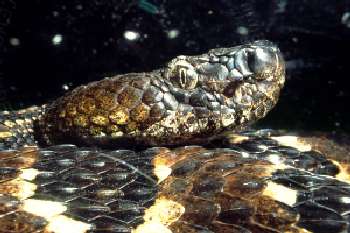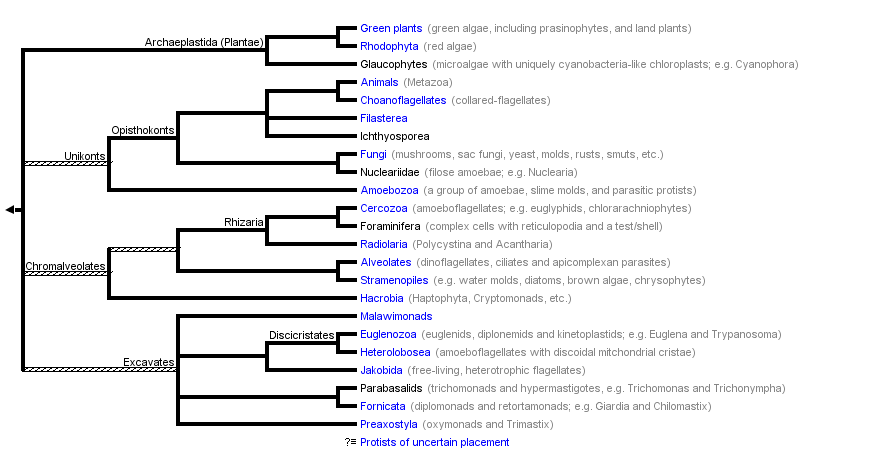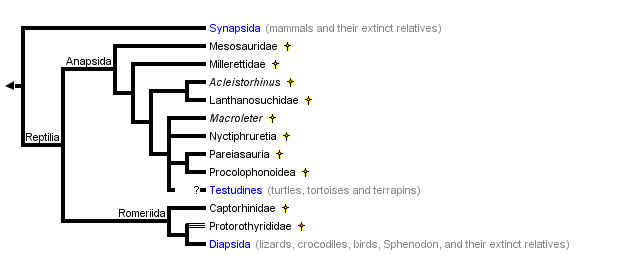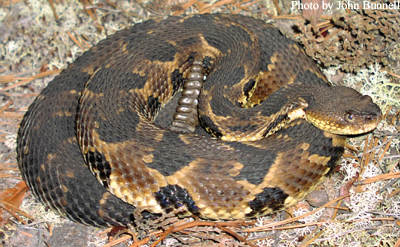Classification and Phylogeny
Domain: Eukarya
Kingdom: Animalia
Phylum: Chordata
Class: Reptilia
Order: Squamata
Family: Viperidae
Genus: Crotalus
Species: Crotalus horridus
Domain Eukarya: C.
horridus is part of this domain primarily because its cells contain
membrane-bound organelles, a true nucleus, and genetic material that
is comprised of multiple, linear strands of chromosomes.
Kingdom Animalia: C. horridus
is considered an animal because it is eukaryotic,
multicellular and heterotrophic, meaning it must consume
other organisms in order to acquire its energy.
Also, like other animals, it is motile, its cells lack a cell
wall, and its embryo undergoes a blastula stage during development.
Phylum Chordata: C.
horridus falls under this phylum for having a notochord, a
hollow dorsal nerve cord, pharyngeal slits, an endostyle, which
is a precursor to the thyroid gland, and a
post anal-tail at some point in its life cycle.
Class Reptilia: C.
horridus belongs to this class because its skin is covered
with scales, it is cold-blooded and it is air-breathing.
Though it doesn't possess four limbs, C. horridus is
considered to be a tetrapod due to the fact that it descended
from vertebrates that had four limbs, which classifies it as a
reptile. Lastly, the
embryos within its eggs are surrounded by a protective membrane known as an
amnion.

Order Squamata: Members of
this order are characterized by the presence of horny scales or
shields on the surface of the skin, as well as the possession of
specialized quadrate bones that allow them to move the upper
jaw relative to the braincase. This powerful movement
permits animals of this order to devour other organisms
whole.
Family Viperidae: This family
is composed of organisms that possess relatively long, hinged
fangs designed for deep penetration and venom injection.
Genus Crotalus: The
genus Crotalus is defined by a group of venomous pit
vipers found only in various regions of North and South America.
Currently, there are only twenty-nine identified species,
including C. horridus. Pit vipers are named for
the presence of a two facial pits located on either side of the
head, long movable fangs and
specialized venom glands that secrete deadly venom. The
Genus Crotalus comes from the Latin word crotalum, meaning "bell"
or "rattle", and from the Greek word krotalon, meaning "rattle",
"castanet", or "little bell".

Species Crotalus horridus:
C. horridus is one of the few types of
rattlesnakes found in the majority of the eastern portion of the United States,
including Wisconsin and Minnesota. The specific epithet,
horridus, comes from a Latin word meaning "dreadful" and is
referring to the venom it produces. It also signifies "rough" or
"bristly", referring to its scaly, bumpy skin.
*Classification information found at
http://zipcodezoo.com/Key/

The general phylogenetic tree above displays the five main Supergroups within the domain Eukarya.
Basically, eukaryotes are defined by many features that separate
them from the prokaryotes, including the presence of an
endomembrane system made up of various intracellular organelles,
a cytoskeleton consisting of microtubules and microfilaments,
the presence of multiple, linear chromosomes contained within a
membrane-bound nucleus and many more. By utilizing molecular
data, scientists were able to reconstruct phylogenies that
resolved any confusion regarding the differences between the
microbial eukaryotes, and the multicellular eukaryotes.
This early molecular data was based on small subunit ribosomal
RNA gene sequences that aided in constructing a ladder that
started with basal lineages and ended with multicellular groups,
such as the animals, plants and fungi. Within the Eukarya
domain, five main Supergroups have emerged. The
differences between the Supergroups are based on
molecular data, morphological characteristics and inter-Supergroup
relationships concerning cell structure and composition.
Each Supergroup contains various lineages leading to a
distinct kingdom or other major grouping, such as the
animals or fungi. One of these Supergroups, the Unikonta,
houses the animals. As shown above, the animals are
members of a more specific grouping within the Unikonta known as
the Opisthokonts. This grouping is characterized by two features
uncommon to all other eukaryotes, which includes
flagellated cells containing a single flagellum situated at the
posterior end of the cell, as well as flat, mitochondrial cristae
found within the cells themselves. Due to these defining
characteristics, animals are most closely related to a group of
unicellular protists known as the choanoflagellates. Since C. horridus
is an animal, it possess these key features common to all
Opisthokonts, and therefore resides in
the Unikonta Supergroup . Other
familiar members of the Unikonta, specifically the Opisthokonts, include the true Fungi, the
parasitic Ichthyosporea, and a group of amoebae called the
Nucleariidae.

This phylogenetic tree is much more refined than
the first tree presented and contains several features that classify the
animals into more specific groupings. The tree directly above
is based on paleontological evidence and evolutionary
relationships among the various clades that stem from a major
group of animals known as the Amniotes. According to the fossil
record, which has documented the origin and evolution of the
Amniotes, relationships between fossils have suggested that the
Amniotes first diverged into two lineages. The first
clade, the synapsids (Synapsida), is comprised of the
mammals and their extinct relatives, while the other clade, the
reptiles (Reptilia) houses a clade of its own known as the diapsids, which includes all
of the living reptiles that we are familiar with today, as well
as the
birds. The diapsids (Diapsida) encompass all of the living lizards, crocodiles, birds, Sphenodon,
and turtles that exist today and all of their
extinct relatives, like the dinosaurs.

In the
tree shown directly above, the diapsids have been divided further into
two clades: the lepidosaurs (Lepidosauromorpha) and the archosaurs (Archosauromorpha).
Lepidosaurs consist of the lizards, snakes and Shenodon
(Tuataras), while
the archosaurs occupy the birds and crocodiles. Besides
these two groups, the tree also shows many of their extinct
relatives, which are indicated by a yellow cross. This
tree is based on paleontological evidence as well as
morphological differences, particularly skeletal. The
diaspsids were given their name primarily because they contain
two fenestrae, or holes, within the temporal region of the
skull, either in the upper or lower region. Some diapsids,
like the lizards, have lost the lower fenestrae only, while
others, such as the snakes, have lost both. This is one of
the skeletal differences that separates the lepidosaurs from the
archosaurs. Within the subclass Lepidosauromorpha, there
exists a more specific group known as the sqaumates (order
Squamata), which includes the lizards and snakes only.
These sqaumates share a recent common ancestor with Sphenodon
(Tuataras),
hence all three are lepidosaurs and are part of the Diapsida
lineage. As stated above, C. horridus is a type
of snake (rattlesnake) and is therefore an avid member of the
order Squamata and all of the clades that precede it.
*To view more phylogenic trees visit
Tree of
Life.com
Back to Home Page
To learn more about the Habitat and Geography of this organism,
click here
